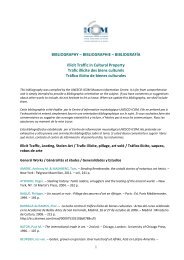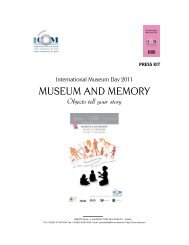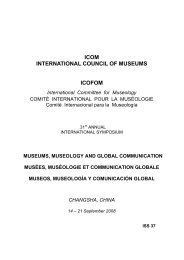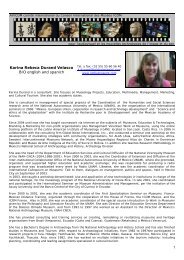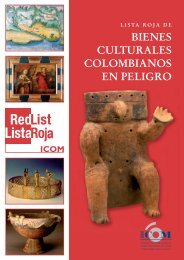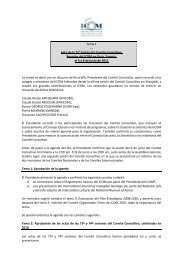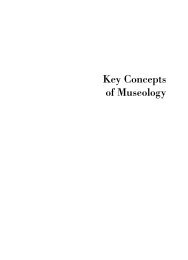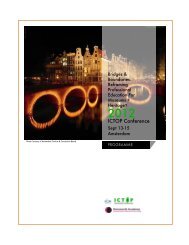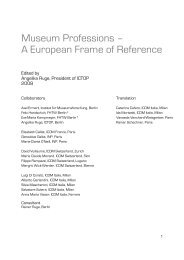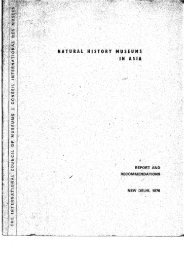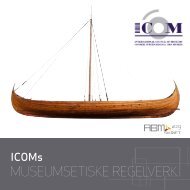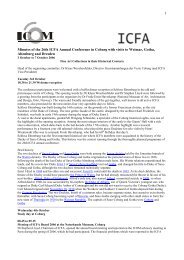ISS 25 (1995).pdf - The International Council of Museums
ISS 25 (1995).pdf - The International Council of Museums
ISS 25 (1995).pdf - The International Council of Museums
Create successful ePaper yourself
Turn your PDF publications into a flip-book with our unique Google optimized e-Paper software.
<strong>The</strong> nature <strong>of</strong> museums<br />
MUSEUMS AND THE COMMUNITY<br />
Lynn Maranda<br />
<strong>The</strong>re are many ways to view the nature <strong>of</strong> a museum and one illustrative way to examine the<br />
museum's character is to ascertain what community the museum serves. It can be argued that<br />
all museums do serve a community and that museums come into existence because <strong>of</strong> that fact.<br />
<strong>The</strong> service which a museum gives a population is one that unites a community by supplying<br />
it with a sense <strong>of</strong> history. <strong>Museums</strong> are another in a list <strong>of</strong> institutions which try to answer the<br />
questions <strong>of</strong> existence which the human race is continually asking. <strong>The</strong> questions <strong>of</strong> "Who are<br />
we?" and "Where did we come from?" are asked in probing rhetoric to help define the purpose<br />
<strong>of</strong> our living and to shape the direction <strong>of</strong> our ambition. It is this sense <strong>of</strong> a community or<br />
population curious to know its beginnings and wanting to know its future that the museum<br />
ful.fils its role in the social order. <strong>Museums</strong> themselves have undergone evolution with the<br />
change <strong>of</strong> social conditions and their own progression from private 'cabinets <strong>of</strong> curiosities' to<br />
monolithic public institutions can be readily traced. What are separate histories accommodated<br />
within a private collection or within a monolithic public institution are histories nonetheless<br />
which make a commitment to the understanding <strong>of</strong> community: one commitment extremely<br />
small, yet deemed <strong>of</strong> great value, the other large and providing a wide opinion to assist in the<br />
understanding <strong>of</strong> a national population.<br />
Hist0IY<br />
A museum is a house in which history is stored. If the purpose <strong>of</strong> history is to write the story<br />
depicting the evolution <strong>of</strong> a peoples from the beginning <strong>of</strong> a determined epoch to the present,<br />
then the present circumstance <strong>of</strong> a community or a people is the major gravitational intellectual<br />
force which determines the attitude <strong>of</strong> written histories. It is by this respect that histories serve<br />
communities and museums, the warehouse <strong>of</strong> historical physical materials, serve up the<br />
evidence <strong>of</strong> given stated historical positions. <strong>The</strong> reason such purposes are required by humans<br />
is that when histories tell stories <strong>of</strong> evolution, they at the same time give special social meaning<br />
to the very readers <strong>of</strong> the evolution. Histories explain the existence <strong>of</strong> a people and even if the<br />
depicted histories do not directly retell the particular story <strong>of</strong> a given population, the very<br />
outlook and fact <strong>of</strong> a population's existence is supported through the act <strong>of</strong> writing. For<br />
example, even the writers <strong>of</strong> history from the Victorian era can expound on subjects other than<br />
their own society as an indirect reinforcement <strong>of</strong> their own social conditions. It is known that<br />
these museums which collected materials from around the world and displayed much <strong>of</strong> its<br />
findings in support <strong>of</strong> notions <strong>of</strong> "savagery" and "racial" types endorsed the European self<br />
67



